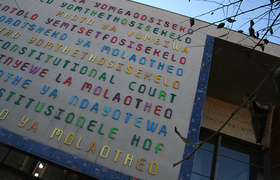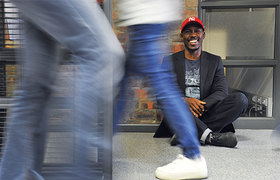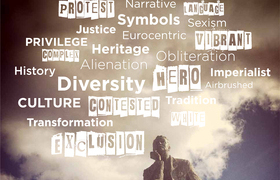New articulation for the site
13 April 2015Assoc Prof Fritha Langerman
Michaelis School of Fine Art
"After the statement issued by the Academics Union and the near–unanimous Senate vote on Friday, there is no longer an open question of what should happen to the Rhodes statue. That it be removed and never returned to the campus is the prevailing opinion on campus, yet following its boarding and removal, a void will appear where it once stood.
"It is this space that is of interest. While bronze male statues have been toppled throughout the world and frequently replaced by other erect, male effigies, I think that it is recognised by the university community that this should be resisted. The concern for many of us is that the university management will respond with the same lack of urgency and imagination as it has in the past.
"Berlin provides a cogent example of how painful histories can be rendered as constant acts of remembrance in the present. Buildings and sites are inscribed with the residue of past acts of violence – silent witnesses to death, removals, destruction and forced separation. This city gives many pointers as to how the archive of our complex past can be woven into the symbolic language of a future UCT.
"To remove the statue without a plan for how the site will be articulated is a mistake, and those departments concerned with visual symbolism – architectural and art departments – must be brought into the discussion early. A forum was held at the Michaelis School of Fine Art last week in which first–year students presented constructive solutions for the site. One idea was that the plinth should become a viewing platform where staff and students would be able to command the view for themselves, symbolically gesturing to their own futures.
"Another suggestion was that the sculpture be melted down and used to cast a plaque commemorating this 'moment of rupture'. Were this possible, a combination of the two may be the most desirable: a bronze, commemorative viewing platform that in transforming a symbol of loathing into one of optimism realises a decisive triumph. This does present a conceptual problem. Has the bronze statue, by a form of transubstantiation, become the tainted body of imperialism?
"In having agreed that the statue should never return to campus, would the reconstituted alloy fundamentally still be Rhodes, or would the act of smelting be the ultimate transformative act, purging the material of its sins and returning it as a symbol of change?"
|
|
 This work is licensed under a Creative Commons Attribution-NoDerivatives 4.0 International License.
This work is licensed under a Creative Commons Attribution-NoDerivatives 4.0 International License.
Please view the republishing articles page for more information.










